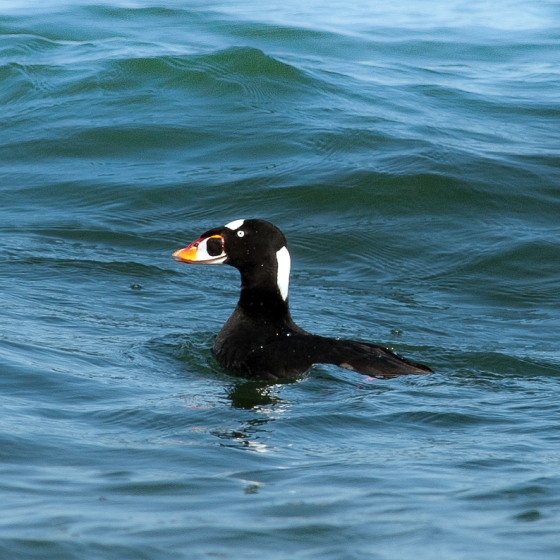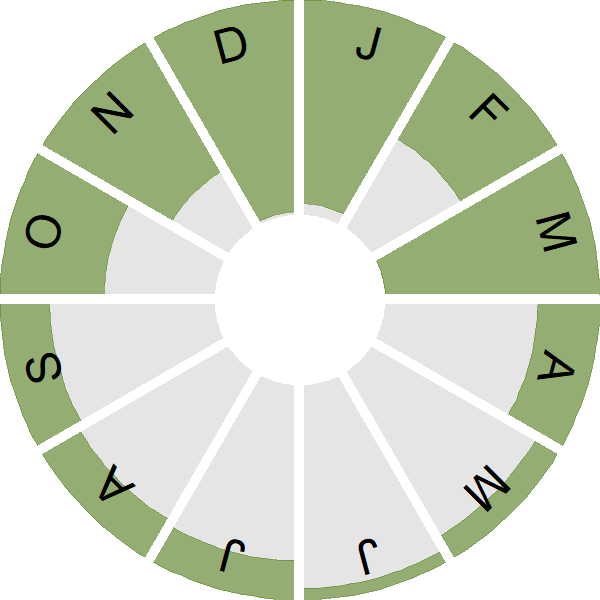Surf Scoter

Introduction
This distinctive seaduck, which breeds in the far north of North America and winters south to Florida and California, is a scarce visitor to Britain & Ireland.
Records from Britain & Ireland mostly fall between October and March, although records off the Aberdeen coast tend to be a little earlier.
Intermediate in size between Common and Velvet Scoters and with a large bill that gives this species a heavy-headed appearance.

Key Stats
Identification
ID Videos
This section features BTO training videos headlining this species, or featuring it as a potential confusion species.
Scoters
Status and Trends
Conservation Status
Population Change
Population trends of this scarce species are not routinely monitored.
Distribution
Surf Scoters are scarce vagrants, with records from many coastal regions.
Occupied 10-km squares in UK
2007/08–10/11
or view it on Bird Atlas Mapstore.
2008–11
or view it on Bird Atlas Mapstore.
Distribution Change
This vagrant has been recorded in several atlases so we have been able to map distribution changes. However, as a rarity these may not show a consistent pattern of change.
Change in occupied 10-km squares in the UK
from 1981–84 to 2007–11
or view it on Bird Atlas Mapstore.
Seasonality
Surf Scoter is a scarce vagrant, recorded throughout the year.
Weekly pattern of occurrence
The graph shows when the species is present in the UK, with taller bars indicating a higher likelihood of encountering the species in appropriate regions and habitats.

Movement
Britain & Ireland movement
Biology
Survival and Longevity
Survival is shown as the proportion of birds surviving from one year to the next and is derived from bird ringing data. It can also be used to estimate how long birds typically live.
Classification, names and codes
Classification and Codes
- Order: Anseriformes
- Family: Anatidae
- Scientific name: Melanitta perspicillata
- Authority: Linnaeus, 1758
- BTO 2-letter code: FS
- BTO 5-letter code: SURSC
- Euring code number: 2140
Alternate species names
- Catalan: ànec negre frontblanc
- Czech: turpan pestrozobý
- Danish: Brilleand
- Dutch: Brilzee-eend
- Estonian: prillvaeras
- Finnish: pilkkaniska
- French: Macreuse à front blanc
- German: Brillenente
- Hungarian: pápaszemes réce
- Icelandic: Krákönd
- Irish: Scótar Toinne
- Italian: Orco marino dagli occhiali
- Latvian: bangu pile
- Lithuanian: baltakakte nuodegule
- Norwegian: Brilleand
- Polish: uhla pstrodzioba
- Portuguese: negrola-de-lunetas
- Slovak: turpan okuliarnatý
- Slovenian: ocalarka
- Spanish: Negrón careto
- Swedish: vitnackad svärta
- Welsh: Môr-hwyaden yr Ewyn
More Evidence
More evidence from Conservation Evidence.com
Partners
Citing BirdFacts
If you wish to cite particular content in this page (e.g. a specific value) it is best to use the original sources as linked in the page. For a more general citation of the whole page please use: BTO (20XX) BirdFacts Species: profiles of birds occurring in the United Kingdom. BTO, Thetford (www.bto.org/birdfacts, accessed on xx/xx/xxxx).

